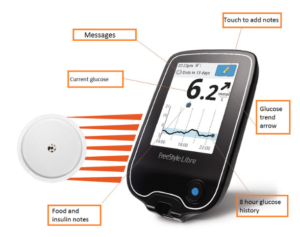
Diabetes Monitoring Technology Moving Toward Consumer Convenience
The FDA recently approved Abott’s FreeStyle Libre Flash Glucose Monitoring System. According to Bloomberg, this device marks the first continuous glucose monitoring system that adults can use that does not use diagnosis via taking fingertip blood samples using a fingerstick.
Traditionally, fingersticks required one to prick their finger to obtain blood droplets for diabetes monitoring devices to work. The Libre flash instead uses a more discreet method of operation–a small sensor wire is inserted below the skin’s surface which continuously measures and monitors glucose levels. According to Abbott, a mobile reader is used to measure glucose levels when a user waves the mobile reader above the sensor wire. It is intended for use in people 18 years of age and older with type I or II diabetes. After an initial 12-hour acclimation period, it can be worn for up to 14 days. Because a diabetic patient’s pancreas can not produce insulin, those patients frequently must monitor their blood sugar and regularly inject themselves with insulin when their blood sugars spike.
Bloomberg and Reuters report that other companies have been left behind. Johnson & Johnson is closing its insulin-pump unit after failing to keep up with Medtronic Plc. DexCom Inc., the current leader in glucose-monitoring systems, which, in turn, lost a third of its market value on Sept. 28 after Abbott’s Libre got approval.
The Centers for Disease Control and Prevention notes that more than 30 million people in the U.S. have diabetes. People with diabetes either do not make enough insulin (type 1 diabetes) or cannot use insulin properly (type 2 diabetes). When the body doesn’t have enough insulin or cannot use it effectively, sugar builds up in the blood. High blood sugar levels can lead to heart disease; stroke; blindness; kidney failure; and amputation of toes, feet or legs.
According to Bloomberg, “the bulk of the sales are to the 1.25 million American diabetes patients with the most severe form of the disease, type 1. There’s a larger, mostly untapped market: the about 20 million Americans with type 2, whose body’s ability to use insulin fades slowly over time and who don’t regularly use tools to manage their disease.”
